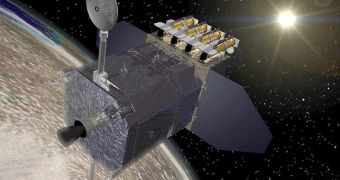Experts at the American space agency are thrilled to announce that their newest Sun-observing telescope has just finished its post-launch check, which means that it has begun its science mission phase. The major accomplishment was achieved on May 14, when the Solar Dynamics Observatory (SDO), the most advanced spacecraft of its kind, officially started its 5-year-long mission to observe subtle variations in the Sun's radiation emissions. The satellite is extremely sensitive in the ultraviolet wavelength range of the electromagnetic spectrum, where the star is very active.
Space Fellowship reports that the Sun's variations cannot be readily seen in other wavelengths. For many years, solar physicists have been wondering as to how is it that the Sun looks so “still” when looking at it in visible light. When experts were curious enough to point extreme ultraviolet (EUV)-sensitive detectors to the star, they noticed that numerous phenomena were taking place in this wavelength range. The SDO was built with the specific purpose of making more sense of these solar events, and was equipped accordingly.
It was officially commissioned to its science phase during a ceremony that NASA held at the SDO Mission Operations Center. The facility is located at the Greenbelt, Maryland-based Goddard Space Flight Center (GSFC). Experts present at the event said that all three science instruments aboard the solar telescope had been successfully tested and calibrated, and that they were ready to be used by scientists for various studies. “This team has worked together for at least six years, and we’re happy because everything has gone so well,” said Liz Citrin, the outgoing project manager of the SDO. She was the leader of the telescope's overall design, engineering, and construction.
“Now that SDO has begun mission operations, we’re doing what the mission was designed to do. Our job now is to execute the requirements on a daily basis, to fly, operate, and do the day-to-day commanding, to collect the data, and to distribute it to the scientists,” added GSFC Space Science Mission Operations mission manager Patrick Crouse. He reminded attendants at the ceremony that SDO was the first mission in NASA’s new Living with a Star Program. The observatory was launched on February 11, 2010, and managed to achieve its planed inclined geosynchronous orbit on March 16.
“We’re at 4 million images already, and counting. The end of commissioning means that we’re no longer verifying that the satellite works. The instruments are turned on and checked out. The data paths are carrying the data to the science teams. The observatory is working great, and it’s just going to get better,” concluded Dean Pesnell, who is a project scientist for the SDO.

 14 DAY TRIAL //
14 DAY TRIAL //